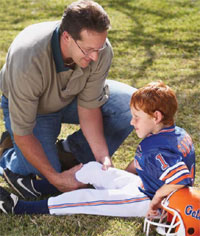This story brings me back to my days in playing field hockey in high school. When I was in 8th grade (my HS 7-12) this rule came into effect, wearing goggles at all times during field hockey. The article
Going Deep: Opinions evenly split on the value of goggles in field hockey refers to the debate that is still going on about whether the goggles are helpful, or add more danger to the game.
This is what a typical field hockey player would wear to a game. When I was in high school, we wore actual goggles with plastic instead of a cage. However, during or hot days, they often fogged, sometimes making it difficult to play. Those type of goggles still exist and are used at the USA field hockey level.
This article goes on to describe how the
National Federation of High Schools has made it a mandate as of April that goggles must be wore at all times during field hockey. This rule is something that Massachusetts players have been following for years. This has caused a lot of outrage in the field hockey community because eye injuries do not occur at a high enough rate to warrant the goggles. At the same time, the medical community is applauding the effort because the eye injuries that are caused by field hockey can be catastrophic.
According to this article a study was done by Dr. Dawn Comstock, and this study claims that 25% of injuries in the sport of field hockey are an eye or facial injury. Field hockey balls travel at high speeds and it takes one deflection or high hit to cause injuries. These goggles do protect the athletes eyes and give a sense of safety to the athletes.
However, in the article it also states that this study was done on a very small scale and another study done by the Catastrophic Sports Injury Research Center in North Carolina found that over 25 years, there were only 2 catastrophic eye injuries recorded. Goggles also reduce the peripheral vision of the athletes and can lead to more collisions as well as not being able to react as quick to a high ball or stick. Coaches have also reported that since this rule has been in effect, more collisions have occured. The reason being is the athletes feel a sense of protection with the goggles and are more likely to make bodily contact. Some high school coaches have reported a high er number of collisions than they have ever seen. There is also the issue that goggles can cause more serious injuries. When two players collided previously, heads may bump and lead to concussions. With the goggles present that might turn into a more serious situation with head and facial lacerations from the goggles.
Cris Maloney a field hockey referee in New Jersey set up a website
GoggleInjury.com less than 2 weeks ago. Already there are 39 total incidents reported and only 1 incident claimed that goggles prevented severe injury while 34 caused or exacerbated the injury.
I have to admit I am torn about this article. One athlete with a catastrophic eye injury is one too many, but how many are getting injured because of the goggles. Either way people are getting hurt and obviously that it something to avoid. I have some bias as well because I was a field hockey player in high school. I played for 6 years and the goggles were just there, I never saw them help or hurt someone. However, I do understand how hard it is to play with them and I have to admit that there seems to be an increased amount of injuries as a direct result.
What do you think?

